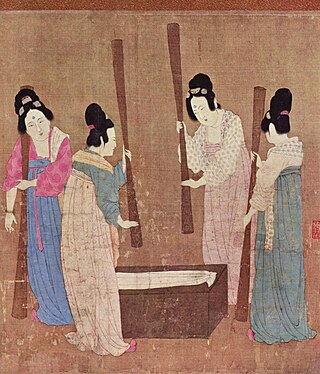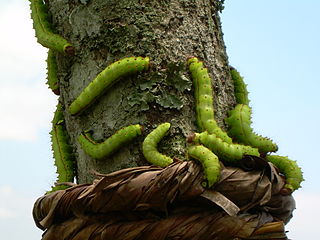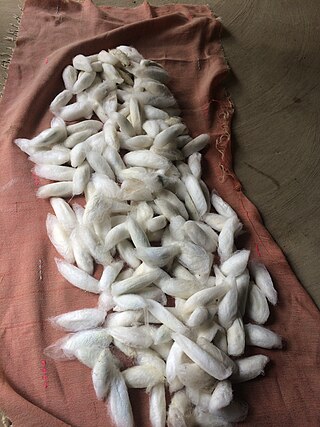
Silk is a natural protein fiber, some forms of which can be woven into textiles. The protein fiber of silk is composed mainly of fibroin and is produced by certain insect larvae to form cocoons. The best-known silk is obtained from the cocoons of the larvae of the mulberry silkworm Bombyx mori reared in captivity (sericulture). The shimmering appearance of silk is due to the triangular prism-like structure of the silk fibre, which allows silk cloth to refract incoming light at different angles, thus producing different colors.

Bombyx mori, commonly known as the domestic silk moth, is a moth species belonging to the family Bombycidae. It is the closest relative of Bombyx mandarina, the wild silk moth. Silkworm are the larvae of silk moths. The silkworm is of particular economic value, being a primary producer of silk. The silkworm's preferred food are the leaves of white mulberry, though they may eat other species of mulberry, and even leaves of other plants like the osage orange. Domestic silk moths are entirely dependent on humans for reproduction, as a result of millennia of selective breeding. Wild silk moths, which are other species of Bombyx, are not as commercially viable in the production of silk.

Sericulture, or silk farming, is the cultivation of silkworms to produce silk. Although there are several commercial species of silkworms, the caterpillar of the domestic silkmoth is the most widely used and intensively studied silkworm. This species of silkmoth is no longer found in the wild as they have been modified through selective breeding, rendering most flightless and without defense against predators. Silk is believed to have first been produced in China as early as the Neolithic period. Sericulture has become an important cottage industry in countries such as Brazil, China, France, India, Italy, Japan, Korea, and Russia. Today, China and India are the two main producers, with more than 60% of the world's annual production.

Mysore Silk is variety of mulberry silk produced in the Indian district of Mysore, Karnataka.

Bombyx is the genus of true silk moths or mulberry silk moths of the family Bombycidae, also known as silkworms, which are the larvae or caterpillars of silk moths. The genus was erected as a subgenus by Carl Linnaeus in his 10th edition of Systema Naturae (1758).

Samia cynthia, the ailanthus silkmoth, is a saturniid moth, used to produce silk fabric but not as domesticated as the silkworm, Bombyx mori. The moth has very large wings of 113–125 mm (4.4–4.9 in), with a quarter-moon shaped spot on both the upper and lower wings, whitish and yellow stripes and brown background. There are eyespots on the outer forewings. The species was first described by Dru Drury in 1773.

Animal fibers are natural fibers that consist largely of certain proteins. Examples include silk, hair/fur and feathers. The animal fibers used most commonly both in the manufacturing world as well as by the hand spinners are wool from domestic sheep and silk. Also very popular are alpaca fiber and mohair from Angora goats. Unusual fibers such as Angora wool from rabbits and Chiengora from dogs also exist, but are rarely used for mass production.

Bombyx mandarina, the wild silk moth, is a species of moth in the family Bombycidae. It is the closest relative of Bombyx mori, the domesticated silk moth. The silkworm is the larva or caterpillar of a silk moth. Unlike the domesticated relative which is unable to fly or indeed persist outside human care, the wild silk moth is a fairly ordinary lepidopteran. Its main difference from the domesticated taxon is the more slender body with well-developed wings in males, and the dull greyish-brown colour.

The production of silk originated in Neolithic China within the Yangshao culture. Though it would later reach other places in the world, the art of silk production remained confined to China until the Silk Road opened at 114 BC. Even after trade opened, China maintained a virtual monopoly over silk production for another thousand years. The use of silk within China was not confined to clothing alone, and silk was used for a number of applications, such as writing. Within clothing, the color of silk worn also held social importance, and formed an important guide of social class during the Tang dynasty.

Thai silk is produced from the cocoons of Thai silkworms. Thailand's silkworm farmers cultivate both types of the domesticated silkworms that produce commercial silk: Samia ricini, commonly known as the eri silkworm, which produces matte eri silk, and the Bombyx mori, producer of the better known, glossy mulberry silk. The latter is by far the larger silk producer of the two.

China is the world's largest and earliest silk producer. The vast majority of Chinese silk originates from the mulberry silkworms. During the larval stage of its life cycle, the insects feed on the leaves of mulberry trees. Non-mulberry silkworm cocoon production in China primarily focuses on wild silk from the Chinese Tussah moth. This moth typically feeds on trees and its larvae spin coarser, flatter, yellower filament than the mulberry silkworms.

Wild silks have been known and used in many countries from early times, although the scale of production is far smaller than that from cultivated silkworms. Silk cocoons and nests often resemble paper or cloth, and their use has arisen independently in many societies.

Eri silk is the product of the domesticated silkworm Samia ricini, found mainly in North East India and some part of China and Japan. It was imported to Thailand in 1974. The name "eri" is derived from the Assamese word "era", which means "castor", as the silkworm feeds on castor plants. Another type of eri silk is "Ailanthus silk moth", refers to the host plant, Borkesseu, Ailanthus excelsa, practiced in China. Eri silk is also known as endi or errandi in India. The woolly white silk is often referred to as the fabric of peace when it is processed without killing the silkworm. This process results in a silk called Ahimsa silk. Moths leave the cocoon and then the cocoons are harvested to be spun. The eri silkworm is the only completely domesticated silkworm other than Bombyx mori.

Tussar silk is produced from larvae of several species of silkworms belonging to the moth genus Antheraea, including A. assamensis, A. paphia, A. pernyi, A. roylei, and A. yamamai. These silkworms live in the wild forests in trees belonging to Terminalia species and Shorea robusta, as well as other food plants such as jamun and oak found in South Asia, eating the leaves of the trees on which they live. Tussar silk is valued for its rich texture and natural, deep-gold colour, and varieties are produced in many countries, including China, India, Japan, and Sri Lanka.

Antheraea pernyi, the Chinese oak tussar moth, Chinese tasar moth or temperate tussar moth, is a large moth in the family Saturniidae. The species was first described by Félix Édouard Guérin-Méneville in 1855. Antheraea roylei is an extremely close relative, and the present species might actually have evolved from ancestral A. roylei by chromosome rearrangement.

Bombyx huttoni, or the chocolate-tipped silk moth, is a moth belonging to the silk moth family, Bombycidae. It is closely related to the domestic silk moth.
The Bangladesh Sericulture Research and Training Institute is an autonomous national research institute that carries out research on sericulture and supports the sericulture industry in Bangladesh. The organization is located in the city of Rajshahi.

The Satellite Silkworm Breeding Station, Coonoor, is an institute that was established by the British Govt. in 1908 for manufacturing surgical suture guts for soldiers of Second World War. During 1919 the station became Sericulture Demonstration Farm-cum-Guts Section. In 1943 by acquiring lands, the Demonstration Farm was converted into Hill Rearing Station. During the years, the increased demand for silk for defense purpose made it imperative for strengthening the station for supply of industrial F1 silkworm seeds. Since the demand for "Foreign Race" to meet the male component necessitated the production of seeds at this station which had favourable climatic conditions the station was converted into Foreign Race Seed Station during 1944 and the station began to collect and maintain different exotic silkworm races from various leading silk producing countries of the World. These races were ultimately supplied to Central Silkworm Seed Station, Sri Nagar in 1958, where they were maintained as Germplasm Bank.
Murshidabad silk is produced in Murshidabad district of West Bengal. This silk is produced from mulberry silkworms reared on mulberry trees. Murshidabad silk is known for its premium quality. This silk is very fine, light weight and easy to drape. Two famous saris produced from Murshidabad silk are Baluchari and Gorood.















